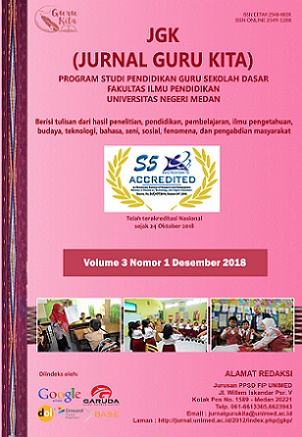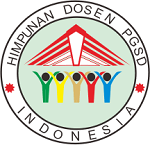KEEFEKTIFAN MODEL MIND MAPPING BERBANTU MEDIA AUDIOVISUAL PADA MATA PELAJARAN IPA TERHADAP HASIL BELAJAR SISWA KELAS IV SD NEGERI JRAGUNG 3 DEMAK
DOI:
https://doi.org/10.24114/jgk.v3i4.14994Abstract
Abstract: The Effectiveness of Mind Mapping Models Assisted by Audivisual Media in Natural Sciences Subjects on Learning Outcomes of Grade IV Students of SDN Jragung 3 Demak. This study aims to determine whether the mind mapping learning model assisted by audiovisual media is effective against the learning outcomes of Natural Sciences subject class IV SD Negeri Jragung 3 Demak.This type of research is quantitative with pre-experimental design research methods with one-group pretest-posttest design. Data in this study were obtained through interviews, documentation, and tests.The results of the analysis of the initial normality test data (pretest) L0 0.1216 <Ltable 0.173 then H0 is accepted and the data comes from the normal distribution. In addition, the results of the analysis of the final normality test data (posttest) L0 0.1081 <Ltabel 0.173 then H0 is accepted and the data comes from the normal distribution. Furthermore, the results of t test analysis obtained tcount 5.374> ttable 1.708 then H0 is rejected and Ha is accepted. On student learning outcomes achieve classical learning completeness with a pretest percentage of 30.77% and 65.38% posttest. The conclusion is that the mind mapping learning model assisted with audiovisual media is effective towards the learning outcomes of Natural Sciences subject class IV SD Negeri Jragung 3 Demak.Keywords:Mind Mapping, Audiovisual Media, Learning OutcomesAbstrak: Keefektifan Model Mind Mapping Berbantu Media Audivisual Pada Mata Pelajaran IPA Terhadap Hasil Belajar Siswa Kelas IV SDN Jragung 3 Demak. Penelitian ini bertujuan untuk mengetahui apakah model pembelajaran mind mapping berbantu media audiovisual efektif terhadap hasil belajar mata pelajaran IPA kelas IV SD Negeri Jragung 3 Demak. Jenis penelitian ini adalah kuantitatif dengan metode penelitian pre-experimental design dengan desain one-group pretest-posttest. Data dalam penelitian ini diperoleh melalui wawancara, dokumentasi, dan tes. Hasil analisis data uji normalitas awal (pretest) L0 0,1216 < Ltabel 0,173 maka H0 diterima dan data berasal dari distribusi normal. Selain itu hasil analisis data uji normalitas akhir (posttest) L0 0,1081 < Ltabel 0,173 maka H0 diterima dan data berasal dari distribusi normal. Selanjutnya hasil analisis uji t diperoleh thitung 5,374 > ttabel 1,708 maka H0 ditolak dan Ha diterima. Pada hasil belajar siswa mencapai ketuntasan belajar secara klasikal dengan persentase pretest 30,77% dan posttest 65,38%. Kesimpulannya bahwa model pembelajaran mind mapping berbantu media audiovisual efektif terhadap hasil belajar mata pelajaran IPA kelas IV SD Negeri Jragung 3 Demak. Kata Kunci :Mind Mapping, Media Audiovisual, Hasil BelajarDownloads
Published
2019-09-20
How to Cite
Saputra, R. D., Saptaningrum, E., & Listyarini, I. (2019). KEEFEKTIFAN MODEL MIND MAPPING BERBANTU MEDIA AUDIOVISUAL PADA MATA PELAJARAN IPA TERHADAP HASIL BELAJAR SISWA KELAS IV SD NEGERI JRAGUNG 3 DEMAK. JGK (Jurnal Guru Kita), 3(4), 332–337. https://doi.org/10.24114/jgk.v3i4.14994
Issue
Section
Articles
License
Authors published with the JGK (Jurnal Guru Kita) agree to the following terms:
- Authors retain copyright and grant the journal the right of first publication with the work simultaneously licensed under a Creative Commons Attribution License (CC BY-SA 4.0) that allows others to share the work with an acknowledgment of the work's authorship and initial publication in this journal.
- Authors are able to enter into separate, additional contractual arrangements for the non-exclusive distribution of the journal's published version of the work (e.g., post it to an institutional repository or publish it in a book), with an acknowledgment of its initial publication in this journal.
- Authors are permitted and encouraged to post their work online (e.g., in institutional repositories or on their website) prior to and during the submission process, as it can lead to productive exchanges, as well as earlier and greater citation of published work. (See The Effect of Open Access)




























